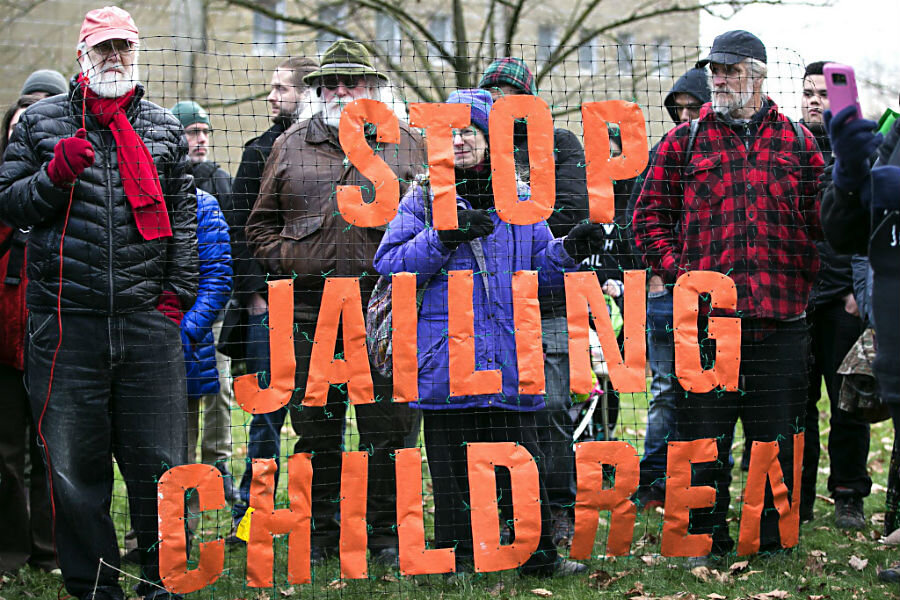Why fewer states are trying teens as adults
Loading...
| NEW YORK
When New York this month raised the age at which young criminal offenders would still be considered juveniles, it was a major change for a state that since 1824 had considered everyone 16 and older as an adult.
New York’s decision to take 16- and 17-year-olds out of the adult criminal system, the result of a bipartisan movement to rethink the get-tough-on-crime laws of the 1990s, is the most recent victory in the effort to move away from a focus on harsh prison sentences, particularly for juveniles.
Anti-crime legislation passed decades ago led the United States to incarcerate more of its residents than any other nation by far, and leaders on both sides of the aisle have looked for ways to change this fiscally challenging trend over the past decade.
Most US states, going back to the 1940s, set 18 as the minimum age to be tried as an adult. Yet in the tough-on-crime era of the 1990s, many states began to again make it easier to process young teens in the adult system.
States passed laws to exclude certain serious crimes, including drug crimes, from the juvenile system altogether. Many gave judges and prosecutors more leeway to decide whether a teen should be tried as an adult.
In the wake of New York’s move on April 10, North Carolina is now the only state that considers 16-year-old offenders as adults by default, and one of only six that include 17-year-olds in the adult system.
Jennifer March, executive director of Citizens’ Committee for Children of New York, marvels at how quickly the “raise-the-age” issue has moved from a grass-roots political push to a significant change in the state’s criminal justice system.
“Four years is short in the life of an advocate,” says Dr. March, whose organization helped establish the state’s “Raise the Age” movement in 2013, when concerns over aggressive policing and calls for criminal justice reform began gaining momentum. “Now we’re hopeful that other states in the country can look to our new law as we roll it out.”
Texas takes action
On April 20 in Texas, one of the six states that considers all 17-year-old offenders as adults, the House passed by a vote of 92 to 52 a similar bill that raises the state’s age of criminal responsibility from 17 to 18. Now the bill turns to the Texas Senate.
Missouri, another of the six states, is also considering a raise-the-age bill.
According to March, a growing body of research, from studies of adolescent brain development, to the rates of recidivism for young teens convicted in the criminal system, to the emotional and physical perils of prison life for 16- and 17-year-olds, have convinced more and more lawmakers that these young offenders, as well as society as a whole, are better served by the juvenile system.
“This issue, it impacts all of us,” says Jeree Thomas, policy director at the Campaign for Youth Justice in Washington. “When you think about the costs of incarceration, when you think about the physical and emotional costs on kids and the results on society once they're released – if we’re able to better serve the needs of those young people to help them become law-abiding citizens, that will positively impact all our lives.”
New York’s new law allows local district attorneys to keep a teen in the adult system, but requires them to prove “extraordinary circumstances” justifying the move. Violent felonies will also remain in the adult system, while other felonies will be moved to a youth division, where judges have specific training in family and childhood development issues.
“The law does also ensure that no young person would be in an adult jail or an adult correction facility,” notes March, citing the research that consistently documents how teens incarcerated with adults are at greater risk of violence, including sexual violence.
Threat to public safety
Opponents of raise-the-age bills, however, worry that not punishing 17-year-old offenders could pose a threat to public safety.
“Sadly, Raise the Age will re-victimize victims by taking them out of the process and allowing defendants to go unpunished,” said Steve Cornwell, the Republican district attorney in upstate Broome County, according to the Rochester Democrat and Chronicle. “And it will lead to the exploitation of children, who drug dealers will prey upon, to sell poisonous drugs, without the threat of criminal prosecution.”
In Texas, state Sen. John Whitmire, a Houston Democrat, worries that juvenile justice facilities, some of which are “out of control and dangerous,” would become even less safe with the addition of 17-year-olds, The Texas Tribune reported.
One of the reasons the raise-the-age bill gained momentum over the past few years, however, were high-profile cases of young teens beaten and abused in New York’s notorious Rikers Island jail complex, which officials have recently agreed to close, a process that could take a decade. Beginning Oct. 1, 2018, offenders 17 and under in New York will no longer be held in county jails. In 2019, 18-year-olds will also no longer be held in adult jails.
Teens in the adult criminal system also have a high rate of suicide, and are much more likely to commit crimes again once they are released, notes Brian Evans, the director of state campaigns at the Campaign for Youth Justice.
“I think for legislators, that fact – the fact that incarcerating kids just doesn’t work for its intended purposes – has been a real driver across party lines, showing that we shouldn’t continue a policy that harms kids and also isn’t providing any kind of benefit to public safety,” Mr. Evans says.
“So it is definitely progress,” he continues. “And it’s part of a trend in which we’re getting almost all US states to start kids under the age of 18 in the juvenile system.”








